The Scarpa Room opens with the science teaching curriculum of the Faculty of Medicine (1771-1773) and the Maria Teresa medal.
Anatomic preparations and original drawings can be admired, perfectly conserved, which Ant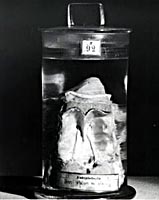 onio Scarpa himself produced in the second half of 1700. Some of them were subjects of his printed publications and properly his discoveries, e.g. the internal ear, the nerves of the heart, the anatomical route of the inguinal hernia, the olfactory nerve and the naso-palatal nerve.
onio Scarpa himself produced in the second half of 1700. Some of them were subjects of his printed publications and properly his discoveries, e.g. the internal ear, the nerves of the heart, the anatomical route of the inguinal hernia, the olfactory nerve and the naso-palatal nerve.
In his treatise On Hernias – an anatomic-surgical Memorandum, Scarpa not only goes into inguinal hernias, which he studies in some detail, but also others li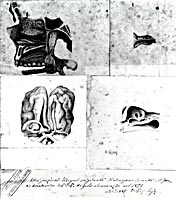 ke the crural hernia, clarifying its relationship with epi-gastric vessels and the spermatic cord.
ke the crural hernia, clarifying its relationship with epi-gastric vessels and the spermatic cord.
The famous Scarpa triangle, with the crural arch as its base, is bounded, on the outside, by the sartorius muscle and, on the inside, by the adductor muscle. The apex of the triangle, created by the meeting of these muscles, points downwards. The triangle is bisceted by femoral artery.
Of particular interest are the anatomic preparations and drawings of them made to demonstrate the naso-palatal nerve and the olfactory nerve. They were shown at the International Anatomy Conference in Paris in 1781 with a note from the great Viq d'Azir, the foremost medical authority of the period, which therefore gave the accolade to Scarpa's importance in the whole scientific world.
There is also a copy of the speech he made on St. Catherine's Day (25th November 17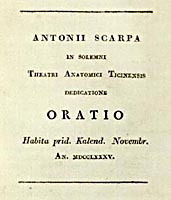 83), his inaugural lecture as Professor of Anatomy, another speech he made in Pavia in December 1785 at the inauguration of the Anatomy Theatre, and a further oration from 1813, entitled "Eulogy on Giambattista Carcano Leone, anatomy professor in Pavia".
83), his inaugural lecture as Professor of Anatomy, another speech he made in Pavia in December 1785 at the inauguration of the Anatomy Theatre, and a further oration from 1813, entitled "Eulogy on Giambattista Carcano Leone, anatomy professor in Pavia".
Also his work on the nerves of the heart, dated 1794, which showed his extreme skill in dissecting, deserves particular mention, since all his contemporaries followed J.B.J. Behrends theory that "cor nervis carere".
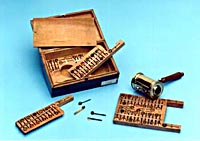 There are also some of Scarpa's hand-written letters and notes. We should particularly remember his autobiography, probably written when he took his retirement, or as he called it, his giubillazione.
There are also some of Scarpa's hand-written letters and notes. We should particularly remember his autobiography, probably written when he took his retirement, or as he called it, his giubillazione.
In the same room, a particularly noteworthy item is the silver and ivory surgical instrument set presented to Scarpa by Napoleon I. It is displayed in the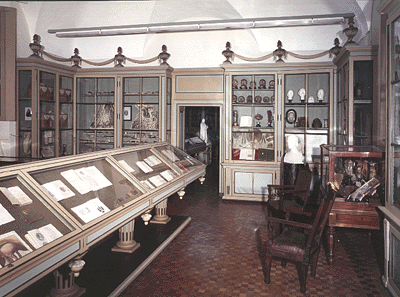 case alongside the precious, Latin folio copy of Instrumentarium chirurgicum, written by Alessandro Brambilla who gave it to Scarpa. It was later passed on to Porta.
case alongside the precious, Latin folio copy of Instrumentarium chirurgicum, written by Alessandro Brambilla who gave it to Scarpa. It was later passed on to Porta.
Another showcase contains some of the most important pieces from the Natural History Museum, described and recorded by Lorenzo Mascheroni in the little poem Invitation to Lesbia Cidonia, with a portrait of the great mathematician and poet.
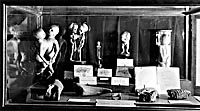 In two specially-made thecae, there are two wax figures of a man and a girl by Clemente Susini, of the Florentine ceroplastic school, modelled after Fonta
In two specially-made thecae, there are two wax figures of a man and a girl by Clemente Susini, of the Florentine ceroplastic school, modelled after Fonta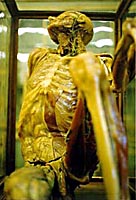 na's dissections. Apart from being of clear didactic utility, since they respectively show the circulatory system and the internal organs of the thorax, they are of considerable artistic merit.
na's dissections. Apart from being of clear didactic utility, since they respectively show the circulatory system and the internal organs of the thorax, they are of considerable artistic merit.
In the case to the right of the door, we find a dry specimen of the kidneys and the urinary tract of Scarpa himself. They show the serious condition of these organs, a factor which determined his death. There are also a case o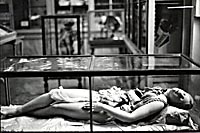 f microscope slides, a simple microscope for looking at them, and a small box of ophthalmic scalpels.
f microscope slides, a simple microscope for looking at them, and a small box of ophthalmic scalpels.
In the same showcase there are other relics: Lazzaro Spallanzani's bladder, very distorted with hypertrophy, a file on The Story of the Illness and Death of Professor Spallanzani, by Valeriano Luigi Brera, and the aneurism of the aorta which caused the death of the geophysicist Brunacci.
There are also wax models of vaccine pustules on a cow's udder and a horse's hoof, which Pietro Moscati got made, a selection of male craniums of, for example, Giovanni Gorini, Giuseppe Moretti, Pasquale Massacra (a painter from Pavia), Antonio Bordoni and other minor characters, plus plaster skulls of Ugo Foscolo, Alessandro Volta, Fran-cesco Petrarca, and Gian Galeazzo Visconti.
In the second wall case is a collection of specimens and associated coloured photographs, which belonged to Angelo Scarenzio, and a collection of anatomic preparations by Jacopo Rezia. His plans are also on view for a teaching laboratory and an anatomy theatre. These designs were never realised but replaced by Scarpa's.
Of Bartolomeo Panizza, we conserve writings and original drawings, some illustrations from his works on lymphatic vessels and their ramifications, plus drawings of the optical system and the central ocular cortex. Panizza's collection of 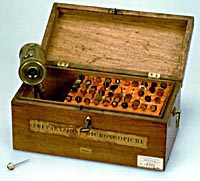 microscope slides represents the transition from microscopes using direct light to those using reflected light.
microscope slides represents the transition from microscopes using direct light to those using reflected light.
A wax model of the human hearing system, in a special display case, was based on Scarpa's discoveries and executed by a pupil of his, Panizza. This model was shown at the 1862 London exhibition and received considerable acclaim.
Mauro Rusconi's admirable illustrations of his works are actually reproductions of the drawings he made with consummate artistic skill, as well as a fin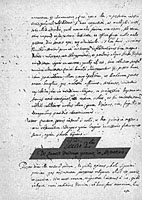 e self-portrait. There is an interesting signed manuscript, which is a fragment of a letter in which he describes, from his point of view, the debate between Rettili and Panizza on the lymphatic system, at a memorable session of the Lombardy Institute of Science and Letters. The debate is also recorded by Panizza's biographers, with comments obviously not in Rusconi's favour.
e self-portrait. There is an interesting signed manuscript, which is a fragment of a letter in which he describes, from his point of view, the debate between Rettili and Panizza on the lymphatic system, at a memorable session of the Lombardy Institute of Science and Letters. The debate is also recorded by Panizza's biographers, with comments obviously not in Rusconi's favour.
In the display case of instruments from the Geodesy Institute of Vincenzo Brunacci's time, we can see three astrolabes, some pairs of compasses, a nautical compass and the wooden reconstruction of a canal lock basin designed by L. da Vinci.
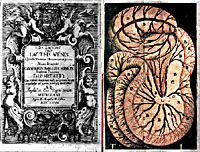 Also in this room we have Brugnatelli's litologia umana, the volcanic material collected by Spallanzani on his trip to the kingdom of the two Sicilies, as well as pre-Scarpa books, manuscripts and instruments. There is a letter from Gaspare Aselli in which he writes about living and teaching in Pavia. A volume of his hand-written notes (Lectiones de venis lacteis) is also on view, dealing with his discovery of the chyliferous vessels, plus a rare example of his work De Lactibus sive lacteis venis, quarto vasorum mesaraicorum genere novo intervento.
Also in this room we have Brugnatelli's litologia umana, the volcanic material collected by Spallanzani on his trip to the kingdom of the two Sicilies, as well as pre-Scarpa books, manuscripts and instruments. There is a letter from Gaspare Aselli in which he writes about living and teaching in Pavia. A volume of his hand-written notes (Lectiones de venis lacteis) is also on view, dealing with his discovery of the chyliferous vessels, plus a rare example of his work De Lactibus sive lacteis venis, quarto vasorum mesaraicorum genere novo intervento.